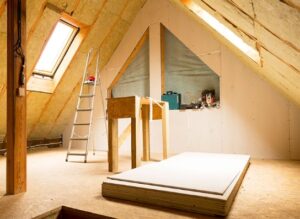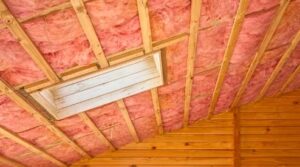No, R13 insulation is not good for ceilings. You can use R13 for interior and exterior walls. But for a better insulation setup for ceilings, make a choice between R30, R38, and R49 insulations.
Is R13 insulation good for ceilings? To know a detailed explanation and other relevant factors, stay with us through the full article.
Key Takeaways
- What Happens If You Use R13 Insulation in Ceiling?
- Minimum R-Value Required for Ceilings
- What Is A Good R-Value for Ceiling Insulation?
- How to Install Ceiling Insulation: Quick Guide
What Happens If You Use R13 Insulation in Ceiling?
For instance, you need thicker fiberglass batt insulation for your ceiling. Because ceilings require thicker insulation to control the heat. Now, if you use R13, which is used for wall insulation, it will not be enough for the ceiling.
Generally, R13 batt insulation is used for interior walls as a soundproofing solution. Also, it is largely used in exterior walls. As this insulation is like a large blanket, it is typically used for walls or floor cavities.
So, you should carefully analyze the difference between wall and ceiling insulation. Though both insulation products are made from the same materials, they have different specifications in terms of thickness.
R values determine the thickness, material, moisture absorption, density, and age of your product. The higher the R-value, the better it can tackle heat transfer. So, make sure to pick the right R-value.
What Is The Minimum R-Value for Ceiling Insulation
The minimum R-value required for the ceiling is R30. It has a high resistance to heat.
However, thickness is an important factor when using the R30 insulation. The required amount depends on the type of climate you’re living in and the ceiling you want to build.
 Source: Mccormickfoy.
Source: Mccormickfoy.
Another type of insulation is blown-in insulation. To achieve the R30 value for this insulation type, you will need 81/2 inches of thickness. The ceiling of your room should also be properly insulated. So, a good R-value is crucial for ceiling insulation.
What Is A Good R-Value for Ceiling Insulation?
According to the Department of Energy’s recommendations, R-30, R-38, and R-49 values are most commonly used for ceilings.
The following table provides a brief overview of these three R-values and how they may benefit you.
| Insulation Type | Used For | Thickness | Cost Per Sq. Ft | Recommended Climate |
| R30 | Ceilings, attics, floors, crawl spaces | 10.25’’ | $1.10 – $1.40 | Warm to moderate |
| R38 | Ceilings, attics, floors, crawl spaces | 12.75’’ | $1.55 – $1.80 | Moderate to cold |
| R49 | Ceilings, attics, floors, crawl spaces | 16.25’’ | $2 – $4 | Very cold and harsh |
While you are insulating your home, you should also know the purpose of sheathing installed on a wall. Most new walls require sheathing as it helps in boosting insulation.
R30 Insulation
Typically, R-30 insulation is used in regions where the climate is warm to moderately hot. The recommended use for R30 is ceilings, attics, floors, and crawl spaces.
That’s why you can easily cover a lot of areas of your home with this insulation. Though R30 does not have a higher R-value, it can still provide efficient insulation for your home.
Moreover, it is comparatively cheaper than the other two insulation. One square foot of R30 cost you between $1.10-$1.40.
R-30 insulation provides the minimum level of heat-transfer loss to your home. You can keep your energy cost to a minimum and also enjoy a comfortable environment inside your home.
 Source: HomeSteady.
Source: HomeSteady.
In general, people consider pink, fluffy batts as the most common insulation. We call it fiberglass insulation. Normally, fiberglass insulation should be 10 inches thick to achieve the R30 value.
R38 Insulation
Insulation R38 is recommended for moderately hot to cold climates. And similar to R30, it is also used in ceilings, attics, floors, and crawl spaces.
So, you can easily use it in many areas of your house. When compared to R30 insulation, it provides 20% more efficiency. As R38 has a higher R-value, it has more capability to resist temperature.
However, it costs more than R30. Per square foot of insulation costs between $1.55 – $1.80.
R49 Insulation
Typically, R49 insulation is used in regions where the climate is very cold. Just like the previous insulations, R49 is used for a wide range of spaces in your home including ceilings.
As it has a higher R-value, it provides greater insulation performance. While some experts suggest that R-38 insulation is sufficient, others recommend using R-49 or higher for optimal effectiveness.
However, remember that R49 is sort of a long-term investment as it costs much more than the previous insulations. One square foot of R49 insulation for the ceiling will cost 2-4$.
While you are picking the perfect insulation, you may also want to choose the right option for your property. In that case, choose wisely between the pole barn and metal building for a worthy construction of your property.
Consider This When Choosing Ceiling Insulation
Keep in mind that specific ceiling insulation recommendations may vary based on many different factors. For example, higher R-values are recommended for higher energy efficiency or harsh climates.
Also, you may contact a professional insulation contractor to know which R-value is perfect for your specific location. Proper insulation in ceilings can significantly impact the energy efficiency and comfort of a building.
Can You Install Ceiling Insulation Yourself?
Yes, you can install ceiling insulation yourself. This quick guide below explains how to install insulation in ceilings.
- Step 1: Make sure you have the correct size, type, and amount of insulation product required for your ceiling.
- Step 2: Gather essential tools such as a utility knife, dusk mask, gloves, and safety glasses. Also, keep a kneeling board around to make yourself comfortable.
- Step 3: Preload the batts into the ceiling space before starting. Start furthest from the manhole and work your way backward. Trim the insulation for a better fit. Make sure to save cutoffs to fill any gap.
- Step 4: Make sure you leave adequate space around ventilation, extractor fans, downlights, and piping. You should put insulation under electrical cables where possible.
However, make sure to follow safety precautions when trying to install the insulation yourself. If in doubt, always contact professionals to solve the issues.
Safety Tips for Installing Ceiling Insulation
- Have your wiring inspected by a licensed electrician.
- Ensure the electricity is switched OFF at the switch box.
- Always wear protective clothing.
- Ensure minimum clearances around downlights, incandescent, and halogen lights to avoid ceiling fire.
- Allow clearance around hot flues, exhaust fans, appliances, and fittings to reduce the risk of fire.
- Be mindful of metals. Metal staples should not be used to secure insulation materials with reflective foil.
FAQs
Is It Necessary To Seal The Base Of My Ceiling?
Yes, R13 insulation works perfectly for exterior walls. It is easy to install because you can wiggle it into place for a snug fit. As it’s essential to have airtight insulation in exterior walls, R13 is a good choice.
How Much Space Is Needed For R30 Insulation?
The cavity depth for installing R30 insulation is 9 inches. Make sure to inspect specific requirements before installing the insulation.
Is A Vapor Barrier Good for Roof Insulation?
Yes, a vapor shield must be installed with your roof insulation. Due to changes in temperature, moisture, and dew can collect on a ceiling. And moisture can cause mold and damage if left unchecked.
Conclusion
Now you know whether R13 insulation is good for ceilings.
As R13 is suitable for interior and exterior walls, choose among R30, R38, and R49 for your ceiling. Remember to pick the right insulation based on your specific requirements.



